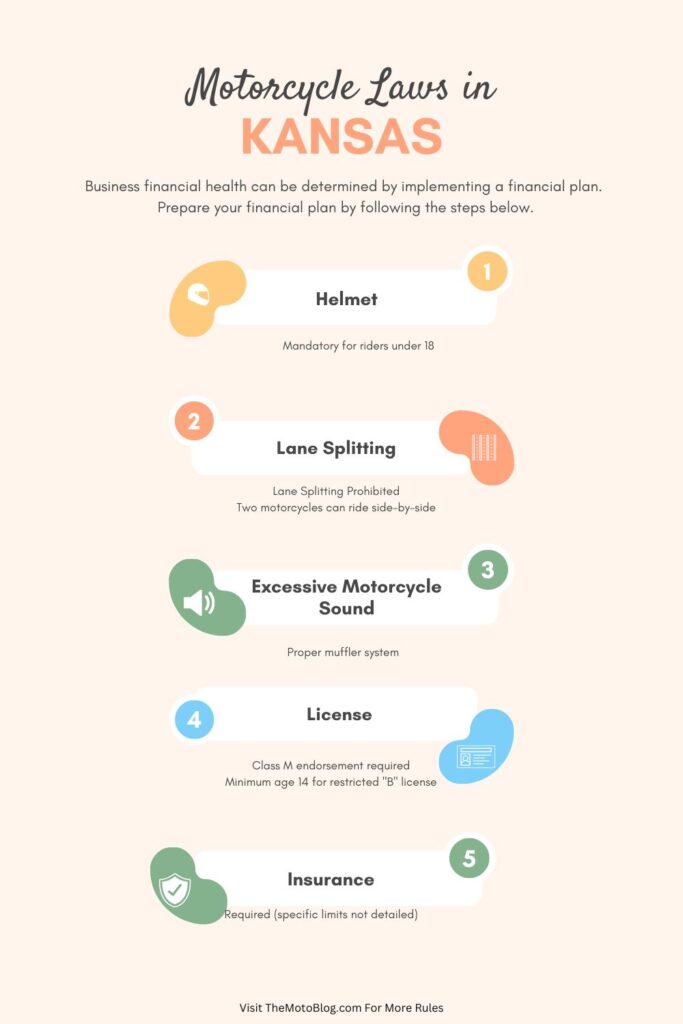Motorcycle Laws in Kansas: A Comprehensive Overview for Riders
The Sunflower State’s motorcycle laws balance freedom with safety, sharing borders and similar regulations with Missouri, Colorado, Oklahoma, and Nebraska. Kansas stands out for its young rider provisions while maintaining strict safety standards for all motorcyclists. Whether you’re cruising through the Flint Hills or commuting in urban areas, understanding these regulations is essential for every rider.

| Requirement | Rule |
|---|---|
| Licensing Age | Minimum age 14 for restricted “B” license |
| License Type | Class M endorsement required |
| Helmet Requirements | Mandatory for riders under 18 |
| Eye Protection | Required unless windscreen is 10+ inches high |
| Lane Splitting | Prohibited |
| Lane Sharing | Two motorcycles can ride side-by-side |
| Required Equipment | – Headlight, taillight, brake light – Turn signals – Two mirrors – Front and rear brakes – Horn |
| Insurance | Required (specific limits not detailed) |
| Passenger Rules | Eye protection mandatory for passengers under 18 |
| Group Riding | Detailed in motorcycle handbook |
Licensing Requirements in Kansas
Obtaining a motorcycle license in Kansas requires a Class M endorsement. The state allows riders as young as 14 to obtain a restricted “B” motorcycle license, making it one of the more accessible states for young riders. All operators must maintain proper motorcycle endorsement on their driver’s license.
Safety Equipment Requirements
Helmet Laws
Kansas enforces mandatory helmet use for riders under 18 years old. All helmets must meet Department of Transportation (DOT) safety standards to ensure maximum protection.
Eye Protection
- Mandatory unless motorcycle has a windscreen at least 10 inches high
- Must be shatter-proof and impact resistant
- Applies to both operators and passengers under 18
Vehicle Operation Rules
Lane Usage and Traffic
- Motorcycles have rights to full lane usage
- Lane splitting/driving between lanes is illegal
- Two motorcycles can ride side-by-side in a single lane
Required Equipment
- Functional headlight, taillight, and brake light
- Working turn signals
- Two mirrors for adequate visibility
- Front and rear brakes
- Horn meeting state specifications
Group Riding and Road Safety
Kansas emphasizes safe group riding practices through its motorcycle handbook, ensuring riders understand proper formation and communication techniques while traveling together.
Neighboring states like Colorado, Oklahoma, and Nebraska share similar safety regulations, though requirements may vary. Riders planning cross-state trips should familiarize themselves with each state’s specific laws.
While Kansas maintains its own unique set of motorcycle laws, riders should remember that regulations can change when crossing state lines. If you’re planning a cross-state adventure, be sure to review the motorcycle laws in Missouri, Colorado, Oklahoma, and Nebraska. For those seeking scenic routes, explore the breathtaking rides in Colorado or the scenic byways of Oklahoma. Remember, safe riding isn’t just about following laws—it’s about enjoying the freedom of the open road responsibly.
Motorcycle Laws in the US By States
If you liked this article, then please subscribe to our YouTube Channel for more Bike Videos. You can also find us on Instagram, Twitter and Facebook.
Disclosure: As an Amazon Associate, I earn from qualifying purchases. Read more about Amazon Affiliate Disclaimer.

Vishwanath Mathpati
I am Vishwanath Mathpati, a full-time Blogger and Motorcyclist from Bidar, Karnataka. I love writing about my Motorcycles Stories and Riding Gears on this blog.
Know More About Me.






